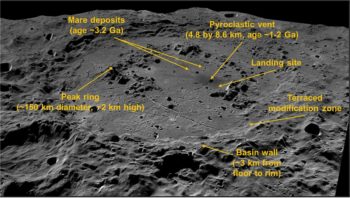
Overview of all landing sites considered in new study.
Credit: E.J. Allender et al./Advances in Space Research
An international team of lunar researchers has blueprinted an exploration scenario for humans and robots to investigate five sites on the Moon. The detailed plan for human lunar surface missions is shaped by science, strategies for surface campaigns, and a Mars-forward perspective.
The proposed missions focus on the Moon’s south polar region and target five sites of diverse scientific interest: Malapert massif, the South Pole/Shackleton crater, Schrödinger Basin, Antoniadi crater, and South Pole-Aitken (SPA) basin.
This study is tied to release of the 2018 Global Exploration Roadmap (GER) developed by the International Space Exploration Coordination Group (ISECG). The focus of the study is how best to explore the south polar region of the Moon, a region that has not been visited by any human missions, yet exhibits a multitude of scientifically important locations – the investigation of which will address long standing questions in lunar research.
Selected sites would be visited in sequential years by crew, beginning in 2028. Two Lunar Electric Rovers are proposed to be tele-robotically operated between sites to rendezvous with crew at the time of the next landing.
The study – “Traverses for the ISECG-GER design reference mission for humans on the lunar surface” – is available online in the journal, Advances in Space Research.

Example of a landing site traverse: This image depicts Malapert massif to South Pole-Aitken basin center.
Credit: E.J. Allender et al./Advances in Space Research
Lunar goals
By visiting the proposed sites, the paper suggests that a suite of lunar investigative goals can be approached:
- The bombardment history of the inner solar system is uniquely revealed on the Moon.
- The structure and composition of the lunar interior provide fundamental information on the evolution of a differentiated planetary body.
- Key planetary processes are manifested in the diversity of lunar crustal rocks.
- Lunar volatiles increase our understanding of the composition state and distribution of volatiles in the lunar polar regions.
- Lunar volcanism provides a window into the thermal and compositional evolution of the Moon.
- The Moon is an accessible laboratory for studying the impact process on planetary scales.
- The Moon is a natural laboratory for regolith processes and weathering on anhydrous airless bodies.
- Processes involved with the atmosphere and dust environment of the Moon are accessible for scientific study while the environment remains in a pristine state.
Site selections
The South Pole-Aitken (SPA) basin is the largest and oldest recognized impact structure in the Solar System.
Malapert massif is a mountainous surface feature located on the lunar nearside. It also contains various small-scale permanently shadowed regions (PSR) which are accessible for exploration and will provide information about extreme conditions in lunar polar environment and volatile composition.
PSRs are ‘cold trap’ areas whose temperatures are cold enough to host water, carbon dioxide, and other volatiles.
Shackleton crater is at the South Pole and is a PSR that may contain icy deposits of volatiles suitable for in situ resource utilization (ISRU).
Schrödinger Basin is inside the SPA basin and formed at the end of the basin-forming epoch on the Moon. It is the best preserved basin of its size in the Earth-Moon system. Moreover, this basin contains pyroclastic material with a localized source vent making it a high-priority ISRU location.
The landing site within Antoniadi crater is noteworthy because it contains the lowest point on the Moon. Antoniadi crater contains both a central peak and a central peak ring structure and is, thus, sometimes classified as a “proto-basin.”

Oblique view of Schrödinger Basin exploration zone.
Credit: E.J. Allender et al./Advances in Space Research
Launches one year apart
The findings of the study, obtained through integration of multiple remotely-sensed lunar datasets, robotic asset capabilities, and communications feasibility, show that a human-assisted robotic mission to the lunar south polar region, including farside locations, can address key lunar science concepts, and would be a valuable resource for the early history and evolution of the Solar System.
For the study, five booster launches, one year apart, is assumed with each launch delivering a team of four crew to eDSH for subsequent surface exploration. The eDSH is a prototype habitat that builds on the expertise, capabilities, and lessons learned from the International Space Station. The plan is enabled by use of the Lunar Orbital Platform-Gateway (LOP-G).
Two Small Pressurized Rovers would be used to explore the lunar surface. Their design is assumed to be a flight-evolved version of the Lunar Electric Rover (LER) that has been field tested here on Earth in 3-day, 14-day, and 28-daylong mission simulations.
This paper led by Elyse J. Allender of the School of Earth and Environmental Sciences, University of St Andrews, St Andrews, UK – “Traverses for the ISECG-GER design reference mission for humans on the lunar surface” – can be found here:
https://www.sciencedirect.com/science/article/pii/S0273117718306604?via%3Dihub

